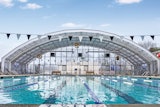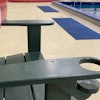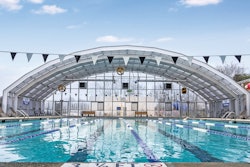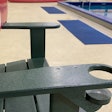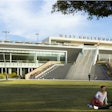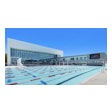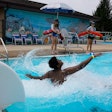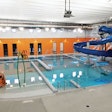Getting an outdoor aquatic facility built within budget often means making some pretty big tradeoffs.
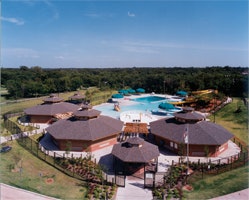
"We've seen so many cases where the community could really utilize a new aquatic facility," he says, "but the rec department's budgetary expectations didn't align with the realities of construction."
The situation is even more pronounced in New England, where the towns are smaller and there's no such thing as a county recreation system, notes Joel Bargmann, a principal with Bargmann Hendrie + Archetype of Boston. "There's just tremendous pressure on these communities to cut costs, and they would rather have something than not have anything," Bargmann says. "They're willing to accept compromises, so it gets to be our job to decide which compromises to put in front of them."
Before you, the frugal pool operator, can decide on which compromises you will make, it is important to realize that the particulars of the sites under consideration will determine whether a large chunk of money will have to be sunk into the project before the pool begins to look like a pool.
"There are certain benchmarks that you have to heed before you even get to the water," Whiteaker says. "A lot of communities start out with a relatively limited budget and have to overcome the extension of infrastructure - sewers, streets, electrical and gas - to the site. Sometimes there are soils and water table issues. A lot of projects end right there - they might have a budget of $1.5 million, and they've taken up almost $1 million of it and don't have a pool or bathhouse yet."
Assuming you have chosen a site needing minimal infrastructure work, it is now time to decide on your general philosophy. Much as recreation centers often feature three nondescript elevations but one grand architectural statement in the entrance lobby - glass-enclosed climbing wall, anyone? - a pool built on a limited budget will possess certain grand qualities and probably a greater number of purely utilitarian features. Put it this way: If the bathhouse approaches sumptuous, the pool itself may suffer.
Dave White, now director of marketing for St. Louis-based Westport Pools, a decade ago was a client of Westport's when Kirkwood (Mo.) Parks and Recreation was building an outdoor aquatic center. "We had to decide between having more deck space or sprucing up the bathrooms, and we eventually decided to put our money in the water," White recalls. "The bathhouse looks decent, but to my mind there was no reason to spend a lot of money on something our patrons would use for 10 minutes a visit."
Whiteaker thinks that is generally a wise course of action. "You have to evaluate what you're trying to accomplish," he says. "A bathhouse, in particular, you want to make unique but not gold-plated, since it's a place where people might not appreciate the architectural statements you make. They might just want to have nice rest rooms, and really want the amenities out in the pool and on the deck - the chairs and shade structures and play equipment."
Jacobs Facilities Inc. of St. Louis, which designed the Kirkwood project, more recently got to witness these different approaches at three pools all within a 10-minute drive of each other in and around Des Moines, Iowa. One facility opted for a multiple-basin pool area and a more standard bathhouse; one saved money by specifying one body of water but then poured the remaining funds into a train-themed bathhouse and scads of water-play equipment; and the third put a great deal of money into a richly detailed and finished, Prairie-style bathhouse that was intended "to set the architectural standard for the city's other public buildings," in the words of Mike Pratl, project manager at Jacobs.
While careful not to express a preference for any one of these plans, Pratl agrees that, in most circumstances, the pool's the thing.
"Sometimes you want to make the site very entertaining, with multiple levels, retaining walls, the types of things that make pools unique," Pratl says. "You have to try to keep the water area big enough to accommodate demand. You don't want to cut back on things like that, where suddenly you've got too small of a facility. Some of the unique features of a pool often become bid alternates, that's for sure."
It's the larger tradeoffs that are the most difficult to make, and usually the most difficult to avoid. As Scot Hunsaker of St. Louis-based CounsilmanHunsaker notes, in most cases budgetary battles are waged over big dollar figures.
"If you're ten or twenty thousand off the number, that's fairly easy to address," Hunsaker says. "But usually, when you have a budget problem, it has at least another zero, so tweaking is pretty tough. What kind of pool controller you buy isn't going to save you $80,000. You need to do something major, like really whack square footage."
One of the biggest money-saving opportunities involves finding a way to consolidate pool operations - but design professionals warn that you may not be able to, and you may not even want to. For example, specifying skimmers instead of a perimeter gutter system could save you a lot of money, but codes for public pools in many jurisdictions simply won't allow it. Nor will some pool builders feel comfortable specifying it, since skimmers either limit the amount of water turnover or require a larger-capacity circulation system to ensure that they won't.
Designers also find themselves butting heads with local code writers in the bathhouse, where the number of toilets and showers required often exceeds what is needed to serve the actual average number of patrons.
"If you go strictly by the code, you can end up with a huge number of showers and toilets, so we often work with state and local agencies to get variances or come up with alternatives," says Bargmann. One such alternative is to allow a smaller shower area on the outside of the building to take the place of part of the typically larger indoor gang shower area, something that also can make it easier for pool staff to direct patrons to shower before entering the pool.
Combining three separate bodies of water into one saves up-front money by limiting the amount of materials used in construction and by consolidating pool-water circulation systems. Also on the plus side, one pool basin can save in operational costs down the line. Same goes for the simplification of other water features. Says White, "When we were building the pool at Kirkwood, three or four more curves in my lazy river would have been cool, but it might have cost me three or four lifeguards at $10 an hour times 100 days times however many seasons. You have to think operationally."
But the money savings isn't as straightforward as that, say pool designers and operators. To begin with, one dysfunctional swim diaper plus one pool basin equals zero revenue - a closed facility instead of one closed pool and two still up and running, says Westport Pools president Jim Bastien. "The savings up-front can end up being fairly significant, but with E. coli and waterborne disease protocols becoming more strict, you have to weigh the savings against how much flexibility you'll have in the case of a pool closure," Bastien says. "How often will you have to clear everybody out? How much revenue are you going to lose on an ongoing basis?"
Second, from a programmatic standpoint, one body of water means one water temperature, which will hamper the operator's ability to run specialized programs such as therapeutic recreation (if too cold) and competitive swimming (if too warm). "It's very hard to expand a pool later," Hunsaker says. "The pool components have to meet the program needs of the project, and a lot of times what the program needs most is revenue potential. More of these projects need to be self-sustaining these days, so you don't want to end up with a white elephant."
Examples abound of pool projects that began looking one way and ended up completely different. Darren Bevard, an aquatic designer with Larkin Aquatics of Kansas City, Mo., says his firm is working with two municipalities whose budgets each are limited to around $1 million.
"The owner can approach the problem in a number of ways," Bevard says. "On one of those projects, we eliminated the deep water after city officials decided they didn't need diving - they obviously wanted it, but they decided that with their budget they weren't going to be able to get it. Now we can add back in a water slide or two and some more interactive features to the remaining leisure pool. The second municipality absolutely wanted diving, so officials kept their diving well. But to reduce the cost, the overall pool size got smaller, and they're not getting as many extra features."
Diving wells and competitive lanes are often eliminated in favor of shallower leisure areas (what designers call "economical water"), but that approach only makes sense if it meets the community's needs and expectations. As Bastien points out, "It has been proven that a competitive area won't add revenue," although White adds that at Kirkwood, "I had a 250-member swim team, which meant I had 500 parents willing to go door to door to help me pass a bond issue."
Many of the cost-saving changes made to a project aren't easily seen by the public, however. For example, Whiteaker identifies back-of-the-house equipment as offering some opportunity for trimming the budgetary fat. "The circulation system of a pool is analogous to the circulation system of the human body, so you want to make sure that no matter what you do you don't compromise its health by specifying inadequate pumps or filters," he says. "That said, you might be able to go with a relatively simple chemical controller, because all of the manufacturers have a high end and then their workhorse center line and their no-frills, lower-cost line."
Two other similar product categories that represent large cash outlays are water-play equipment and perimeter fencing. It is not only possible to purchase water-play equipment at varying price points, but phasing of installation can also be planned so that pieces of equipment are added as more funds become available. Designers will typically provide for extra piping and circulation capacity so that equipment can be added in the future, and deftly provide a layout within a larger amount of economical water that ensures future expandability without leaving patrons with a sense there's a "hole" in the facility. Perimeter fencing, meanwhile, is available in a high-end, black-coated steel version that Pratl says "disappears into some settings," and yet the vast majority of projects are built with the lowest-end product (chain-link) specified. "Most of the time you put something nicer near the entrance and then standard chain-link elsewhere," Pratl says, "because most people are looking at the pool, not the fence."
And, as noted, most people are looking at the pool and not the bathhouse, which is why bathhouse architecture is so often cut back for budgetary reasons. A common result is therefore a rectilinear form (architect-speak for "box") made of inexpensive materials (chiefly concrete block), with a standard pitched, shingled roof. "You can cut costs by utilizing simple building materials and not having a lot of unusual angles," Whiteaker says, "but it doesn't have to be the proverbial pillbox."
Bargmann Hendrie + Archetype often tries to build bathhouses using warmer, though still relatively inexpensive materials, such as wood siding that doesn't require a finish. "Cedar shingles that can naturally weather look a lot better than concrete block, are softer and more park-like, and some sort of nice roof element can help," says Bargmann. "But the key is to make the building small so you can make it nice. That means you have to bring the building down to the essentials - the lifeguard area won't get separate rest rooms, for example - and this is not always the most desirable way to do it."
This is also not easy to accomplish. Consolidation, an earlier money-saving strategy, may have placed the mechanical room underneath the bathhouse, and revenue generation (another money-saving strategy) may have placed a concessions area under the same roof. Add to that necessary features such as a first-aid room, lifeguard office and men's, women's and family locker rooms, and it's no wonder that some bathhouses take up half of the budget for the entire pool project.
"Potty parity laws, ADA and industry standards for family changing rooms all have made bathhouses bigger," says Hunsaker. "Because of that, the trend we're seeing at municipal aquatic facilities is changing spaces becoming smaller and more simple. No longer do we have basket rooms, and if we're providing lockers we're providing them out on the deck, so the building can be made smaller."
Pool designers are used to prospective pool owners blanching (or worse) at the projected bathhouse cost. "You come in with a 5,000-square-foot bathhouse that might cost $800,000 and, comparing that number to the cost of their home, they say, `Oh my God, it's the Taj Mahal!' " Hunsaker says. "And it's not. Your home is made of timber and drywall, which would last five minutes in a recreation facility. Also, the bathroom is the most expensive room in your home, and this is a really big bathroom."
Trying to cut the cost of building a pool is mostly difficult because so many of the costs are fixed. Pools of similar size will require a fixed amount of concrete, steel, piping, earthwork and so on, and the mechanical system, bathhouse, water-play equipment and so forth needed to fill out the final product will be roughly similar in price to another pool of comparable size.
Bevard, therefore, notes that a prime opportunity to hold down costs occurs in the writing of the specifications for the project. "The approach we take is to establish a competitive bidding atmosphere," he says. "A lot of aquatics designers design great facilities, but their projects are only biddable by specialized pool contractors because of the level of detail involved. What we try to do when putting together construction documents is to make sure the level of detail is there so any contractor can bid the project. That opens the job up to local contractors, and that automatically establishes the competitiveness needed to reduce costs."
This, of course, involves a tradeoff - between the job being carried out by an experienced national outfit versus a local company possibly being in over its head. This can be taken care of, Pratl points out, by inserting a requirement into the request for proposal that bidders have a certain number of years of experience or a certain level of experience with pools of similar size and complexity. "You might also write your specs so that either a gunite contractor or a concrete contractor can bid on the contract," Pratl says. "That's another way to bring in multiple bidders."
The same is true, Bevard adds, when specifying pool equipment. "You should always specify and approve several different manufacturers," he says. "If you specify one, they can charge you whatever they want."









